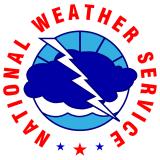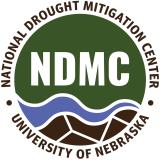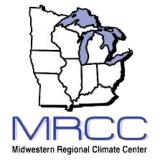Dry Weather Drives Rapid Expansion of Drought Across Midwest.
Drought Likely to Develop Further Across the Central Midwest.
Key Points
- Extremely dry conditions across the Lower Midwest led to rapid expansion of Abnormally Dry (D0) and Moderate to Severe Drought (D1-D2) conditions across Missouri, Kentucky, Illinois, Indiana, and Ohio. Dry conditions in Michigan also drove persistent Moderate to Severe Drought (D1-D2) across central Michigan since Fall 2024.
- Drought impacts are increasing across Missouri, Kentucky, Illinois, Indiana, and Ohio. Impacts include declining soil moisture, below-normal streamflow, and harm to agriculture and livestock production. These impacts will likely continue as drought persists. Drought may soon increase risk of field fires and reduce the length of and intensity of fall foliage.
- The dry conditions decreased flows on the Ohio River. The current forecast for continued low-water conditions triggered some navigation restrictions on the Mississippi River. South of Cairo, Illinois, the U.S. Coast Guard issued tow width and weight restrictions to avoid grounding issues.
- Due to the potential for continued dry conditions and the return of above-normal temperatures by mid-September, drought is expected to persist through September across southeastern Missouri, far western Kentucky, southern and central Illinois, and Michigan. Further drought development is expected across Missouri, Illinois, Indiana, Ohio, northwest Kentucky, and southern Michigan.
This update is based on data available as of Thursday, September 4, 2025 at 8:00 a.m. CT. We acknowledge that conditions are evolving.
The U.S. Drought Monitor depicts the location and intensity of drought across the country. The map uses 5 classifications: Abnormally Dry (D0), showing areas that may be going into or are coming out of drought, and four levels of drought (D1–D4).
The U.S. Drought Monitor is a joint effort of the National Oceanic and Atmospheric Administration, U.S. Department of Agriculture, and National Drought Mitigation Center.
A drought index combines multiple drought indicators (e.g., precipitation, temperature, soil moisture) to depict drought conditions. For some products, like the U.S. Drought Monitor, authors combine their analysis of drought indicators with input from local observers. Other drought indices, like the Standardized Precipitation Index (SPI), use an objective calculation to describe the severity, location, timing, and/or duration of drought.
Learn MorePeriods of drought can lead to inadequate water supply, threatening the health, safety, and welfare of communities. Streamflow, groundwater, reservoir, and snowpack data are key to monitoring and forecasting water supply.
Learn MoreDrought can reduce the water availability and water quality necessary for productive farms, ranches, and grazing lands, resulting in significant negative direct and indirect economic impacts to the agricultural sector. Monitoring agricultural drought typically focuses on examining levels of precipitation, evaporative demand, soil moisture, and surface/groundwater quantity and quality.
Learn MoreU.S. Drought Monitor Categories
D0 - Abnormally Dry
Abnormally Dry (D0) indicates a region that is going into or coming out of drought. View typical impacts by state.
D1 - Moderate Drought
Moderate Drought (D1) is the first of four drought categories (D1–D4), according to the U.S. Drought Monitor. View typical impacts by state.
D2 - Severe Drought
Severe Drought (D2) is the second of four drought categories (D1–D4), according to the U.S. Drought Monitor. View typical impacts by state.
D3 - Extreme Drought
Extreme Drought (D3) is the third of four drought categories (D1–D4), according to the U.S. Drought Monitor. View typical impacts by state.
D4 - Exceptional Drought
Exceptional Drought (D4) is the most intense drought category, according to the U.S. Drought Monitor. View typical impacts by state.
Total Area in Drought (D1–D4)
Percent area of the Midwest that is currently in drought (D1–D4), according to the U.S. Drought Monitor.
The U.S. Drought Monitor depicts the location and intensity of drought across the country. The map uses 5 classifications: Abnormally Dry (D0), showing areas that may be going into or are coming out of drought, and four levels of drought (D1–D4).
The U.S. Drought Monitor is a joint effort of the National Oceanic and Atmospheric Administration, U.S. Department of Agriculture, and National Drought Mitigation Center.
The U.S. Drought Monitor is released every Thursday morning, with data valid through the previous Tuesday at 7 a.m. ET.
A drought index combines multiple drought indicators (e.g., precipitation, temperature, soil moisture) to depict drought conditions. For some products, like the U.S. Drought Monitor, authors combine their analysis of drought indicators with input from local observers. Other drought indices, like the Standardized Precipitation Index (SPI), use an objective calculation to describe the severity, location, timing, and/or duration of drought.
Learn MorePeriods of drought can lead to inadequate water supply, threatening the health, safety, and welfare of communities. Streamflow, groundwater, reservoir, and snowpack data are key to monitoring and forecasting water supply.
Learn MoreDrought can reduce the water availability and water quality necessary for productive farms, ranches, and grazing lands, resulting in significant negative direct and indirect economic impacts to the agricultural sector. Monitoring agricultural drought typically focuses on examining levels of precipitation, evaporative demand, soil moisture, and surface/groundwater quantity and quality.
Learn MoreCurrent Conditions and Impacts for the Midwest
- Extremely dry conditions across the Lower Midwest led to the rapid expansion of Abnormally Dry (D0) and Moderate to SevereDrought (D1-D2) conditions across Missouri, Kentucky, Illinois, Indiana, and Ohio. Dry conditions in Michigan also drove persistent Moderate to Severe Drought (D1-D2) across central Michigan, which has been in drought since fall 2024.
- According to the U.S. Drought Monitor, 14% of the Midwest is currently in Moderate to Severe Drought (D1-D2), with an additional 33% Abnormally Dry (D0).
- Kentucky and Missouri experienced a significant increase in drought conditions, with 95% of Kentucky and 94% of Missouri now classified as Abnormally Dry (D0) or in Moderate Drought (D1), according to the U.S. Drought Monitor. These states had no drought or dryness on the July 29, 2025 map.
- Drought impacts are increasing across the region, including declining soil moisture, below-normal streamflow, negative impacts to agriculture and livestock production, lack of food and water for wildlife (which is leading to disease or death), and brown or dead lawns.
- Impacts to livestock production include very low surface ponds and very poor pasture conditions across portions of Missouri, Kentucky, Illinois, Indiana, and Ohio. In some areas, supplemental feeding is required, and growers in Missouri, Kentucky, and Ohio reported hauling water for livestock.
- Crop conditions remain good across much of the Midwest. However, the recent dryness harmed crops across Missouri, Kentucky, Illinois, Indiana, and Ohio. Impacts from a lack of moisture include stunted corn growth, rapid dry-down of crops before reaching maturity, early dormancy in vegetation, and soybean pods not filling out with beans.
- The dry conditions have reduced flows and lowered river stages on the Ohio River to below 15 feet at Cairo, Illinois. Navigation restrictions took effect on the Mississippi River due to current low water and forecasts that river levels will continue to fall through September. South of Cairo, Illinois, the U.S. Coast Guard issued restrictions on the width of tows and how much they can carry in order to avoid grounding issues.
Drought Expanded Across Lower Midwest Since Late July
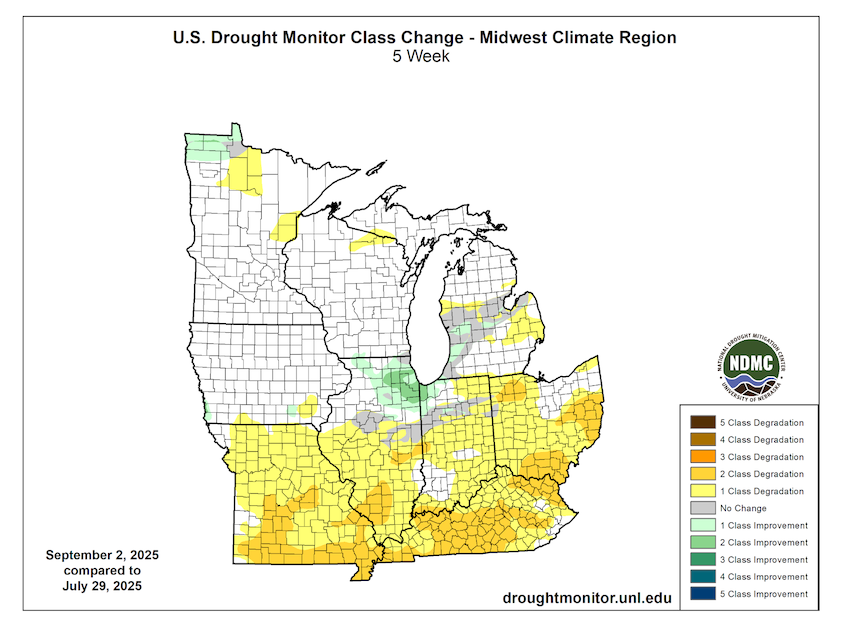
Very Dry August for Majority of the Midwest

Insufficient Soil Moisture for Vegetation Across Portions of Midwest
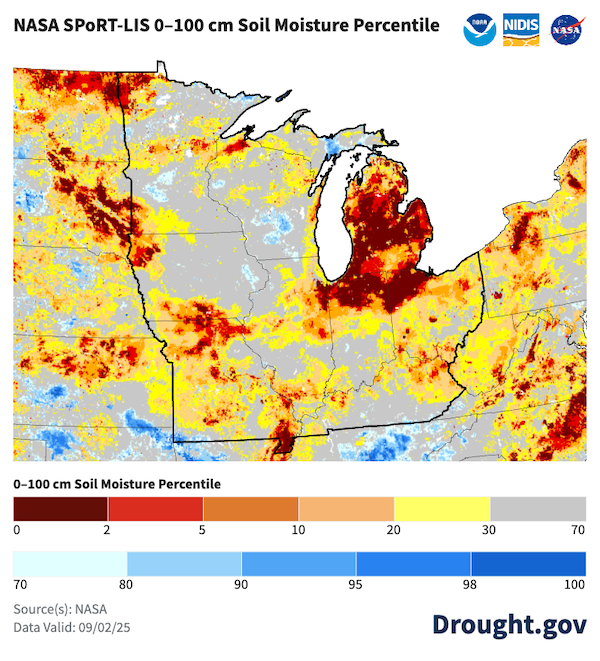
Outlooks and Potential Impacts in the Midwest
- The National Weather Service’s (NWS) short-term precipitation forecast for September 3–10 shows the potential for beneficial rain across much of Kentucky and northern Michigan. However, areas in drought across Missouri, Illinois, Indiana, Michigan, and far western Kentucky are not forecast to receive much rainfall.
- The NWS Climate Prediction Center’s 8-14 day outlook for September 11–17 shows increased chances for below-normal precipitation across much of the eastern Midwest, particularly across Michigan, Ohio, eastern Indiana, and northeast Kentucky. Temperatures during this time frame are expected to be above normal across the Midwest, with the exception of far-eastern portions of the region.
- Drought is expected to persist through September across southeastern Missouri, far western Kentucky, southern and central Illinois, and Michigan due to the forecast dry conditions and the return of above-normal temperatures. New drought development is expected across Missouri, Illinois, Indiana, Ohio, northwest Kentucky, and southern Michigan.
- By the end of September, drought is expected to end in eastern Kentucky and southwestern Missouri.
- Persistent and/or expanded drought in September would likely lead to increased risk for field fires during harvest, further drying of soils, below-normal streamflow, continued very poor pasture conditions and low livestock ponds, and continued early dry-down of crops and stunted growth.
- Drought stress may also shorten the fall color season, lead to early and less vibrant colors, and cause leaves to turn brown and fall before peak color displays occur.
Short-Term Beneficial Rainfall Likely for Kentucky
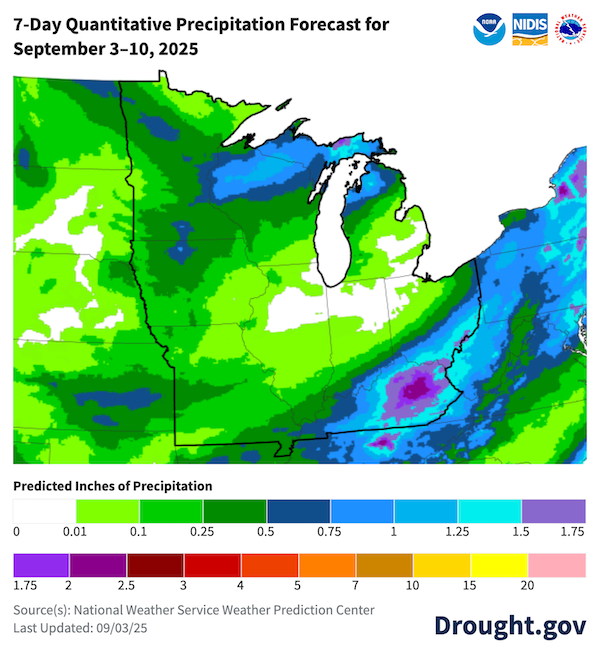
Below-Normal Rainfall Expected in Mid-September Over Eastern Midwest
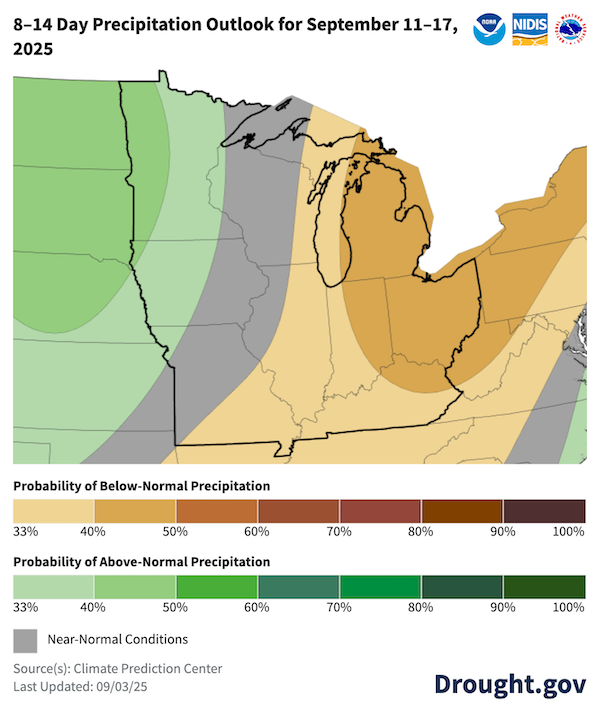
Drought Expected to Expand Across Central Midwest in September

Resources
- Register for the Drought in the Midwest Webinar: Conditions, Outlooks, and Resources on October 2, 2025 at 2 p.m. CT. The webinar will address current and developing drought conditions, drought impacts across sectors and industries, and outlook information for the coming months and seasons.
- More local information is available from the following resources:
- To report or view local drought impact information:
Prepared By
Molly Woloszyn
Cooperative Institute for Research in Environmental Sciences/NOAA National Integrated Drought Information System (NIDIS)
Austin Pearson
Midwestern Regional Climate Center/Purdue University
Anna Wolverton
U.S. Army Corps of Engineers Mississippi Valley Division/NOAA National Weather Service
Zack Leasor
University of Missouri/Missouri State Climate Office
Trent Ford
University of Illinois/Illinois State Water Survey & Climate Office
The following people also contributed to the development of this report: Melissa Widhalm (Midwestern Regional Climate Center/Purdue University), Jim Noel and Molly Peters (NOAA National Weather Service Ohio and North Central River Forecast Centers), Dennis Todey (U.S. Department of Agriculture Midwest Climate Hub), and Denise Gutzmer (National Drought Mitigation Center).
A special thank you to the state climate offices and National Weather Service offices in the Midwest region for providing local information on drought conditions and impacts included in this Drought Status Update.
This Drought Status Update is issued in partnership between the National Oceanic and Atmospheric Administration (NOAA), U.S. Department of Agriculture (USDA), U.S. Army Corps of Engineers (USACE), and the National Drought Mitigation Center to communicate a potential area of concern for drought expansion and/or development within the Midwest region based on recent conditions and the upcoming forecast. NIDIS and its partners will issue future Drought Status Updates as conditions evolve.




